





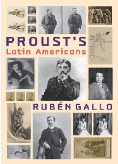 Proust's Latin Americans – Johns Hopkins University Press
Proust's Latin Americans – Johns Hopkins University Press
Gallo, Ruben
Juin 2014
"One of the least studied figures in Proust's circle is the artist Antonio de La Gandara (1861-1917), born in Paris to a Mexican father and a Franco-English mother. La Gandara, who lived as a Mexican citizen in France until he naturalized at age thirty-four, studied at the Ecole du Louvre, set up a studio in Montmartre, and gained success as a society painter. Like Jacques-Emile Blanche (1861-1942), he created portraits of some of the most celebrated figures of the belle époque, including many of Proust's friends and acquaintances: Anna de Noailles, Elisabeth de Caraman-Chimay, Louisa de Mornand, Sarah Bernhardt and Paul Verlaine. But while Blanche has been the subject of important publications, La Gandara has slipped into relative oblivion. During Proust's time, however, he was a well-known artist, and his portraits hung in the many salons Proust frequented during his socialite years.
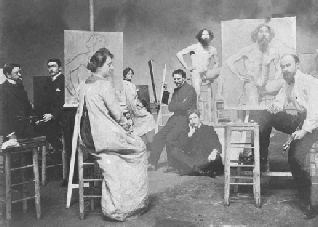 One of La Gandara's most impressive Works is his 1891 sketch of Yturri Reading a book. Gabriel appears seated by a table, elegantly dressed in a black jacket and wearing an Ascot; his youthful face shines with wonder and illuminates the book that captures his entire attention, while the rest of the composition dissolves into darkness. This work could have been called Portrait of the dandy reading.
One of La Gandara's most impressive Works is his 1891 sketch of Yturri Reading a book. Gabriel appears seated by a table, elegantly dressed in a black jacket and wearing an Ascot; his youthful face shines with wonder and illuminates the book that captures his entire attention, while the rest of the composition dissolves into darkness. This work could have been called Portrait of the dandy reading.
In 1896, La Gandara painted Reynaldo’s sister, Maria, who had married the painter Raimondo de Madrazo (1841-1920), a relative of Marion Fortuny, one of the most celebrated designers of the belle-époque. In 1916, Marcel would write Maria asking her for specific details about Fortuny robes he planned to include in his novel. Earlier, Maria had put Proust in touch with her cousin, Marie Nordlinger, who helped him translate Ruskin’s Sesame and the Lys and The Bible of Amiens. During this time, La Gandara – along with Reynaldo, his sister Maria, and Yturri – was a key presence in Proust’s circle of Latin American friends.
After Yturri’s death in 1905, La Gandara sent Montesquiou a condolence letter, telling him that Gabriel, from the grave “sees with joy how much you love him!” The count replied that “your conduct during these days, during these last hours, has proven to me once more that you belong to those [select souls], and it will reaffirm our friendship by adding sights to our memories. In Le chancelier de fleurs, Montesquiou hailed La Gandara – along with Paul Helleu, Maurice Lobre, Georges Hoenstschell, Federico de Madrazo y Ochoa, and Proust – as one of Yturri’s close friends. The count quotes several letters in which Yturri had written about spending time with the painter and his family in Paris or in La Gandara’s native city of Blois.
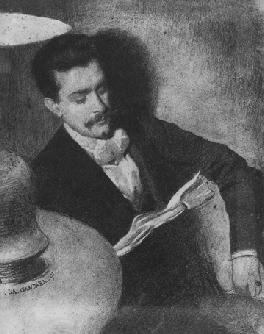 Proust met La Gandara while he was still in his twenties. He became close to Antonio and also befriended his brother Edouard, an actor who worked with Sarah Bernhardt and later became an antiquarian. In 1897, Marcel invited Antonio – along with Anatole France, Montesquiou, Yturri, Reynaldo, and several aristocrats – to one of the dinners he organized at his parent’s apartments. La Gandara and Proust were both socialites, and they crossed paths often at receptions and dinners. In “Une fête littéraire à Versailles”, Marcel’s 1894 chronicle of one Montesquiou’s extravaganzas, he mentions La Gandara, along with Heredia, among the guests. La Gandara also plays an important role in Jean Santeuil, where, in a fictional scene, he paints the portrait of the protagonist. The unfinished novel includes a long passage describing the imaginary painting.
Proust met La Gandara while he was still in his twenties. He became close to Antonio and also befriended his brother Edouard, an actor who worked with Sarah Bernhardt and later became an antiquarian. In 1897, Marcel invited Antonio – along with Anatole France, Montesquiou, Yturri, Reynaldo, and several aristocrats – to one of the dinners he organized at his parent’s apartments. La Gandara and Proust were both socialites, and they crossed paths often at receptions and dinners. In “Une fête littéraire à Versailles”, Marcel’s 1894 chronicle of one Montesquiou’s extravaganzas, he mentions La Gandara, along with Heredia, among the guests. La Gandara also plays an important role in Jean Santeuil, where, in a fictional scene, he paints the portrait of the protagonist. The unfinished novel includes a long passage describing the imaginary painting.
Cette année-là La Gandara exposa au Champ de Mars un portrait de Jean Sainteuil. Ses anciens camarades d’Henri IV n’auraient certainement pas reconnu l’écolier désordonné, toujours mal mis, dépeigné, couvert de taches, l’attitude fiévreuse ou abattue, le geste plus expressif que noble, le regard exalté s’il était seul, timide et honteux s’il était devant le monde, toujours pâle, les yeux tirés, cernés par l’agitation, l’insomnie ou la fièvre, le nez trop fort dans les joues creuses avec de grands yeux pensants qui versaient seuls quelques beauté, avec leur lumière et leur tourment, sur cette figure irrégulière et maladive, dans le brillant jeune homme qui semblait encore poser devant tout Paris, sans timidité comme sans bravade, le regardant de ses beaux yeux allongés et blancs comme une amande fraîche, des yeux plus capables de contenir une pensée qu’en ayant pour le moment aucune, comme un bassin profond mais vide, les joues pleines et d’un rose blanc qui rougissait à peine aux oreilles que venaient caresser les dernières boucles d’une chevelure noire et douce, brillante et coulante, s’échappant en ondes comme au sortir de l’eau. Une rose coupée au coin de son veston de cheviote vert, une cravate d’une légère étoffe indienne qui imitait les ocellures de paon, venaient témoigner à la vérité de sa mine lumineuse et fraîche comme un matin de printemps, de sa beauté, non pas pensante mais peut-être doucement pensive, de la délicatesse heureuse de sa vie. Et pourtant M. et Mme Santeuil qui avaient d'abord encouragé Jean à aller dans le monde, qu'avait bientôt flattés la grande situation qu'il s'y était faite, étaient ennuyés de voir Jean ne plus travailler, ne plus lire, ne plus penser, et n'en avoir même plus, au moins depuis quelques mois, de regrets ni de honte. (That year Le Gandara exhibited at the Champ-de-Mars a portrait of Jean Santeuil. His former companions at the Lycée Henri IV would certainly not have recognized the untidy schoolboy – always badly dressed, with tousled hair and stained clothes, his manner either feverishly excited or dejectedly limp, his gestures expressive rather than well-bred, with exaltation in his face when he was alone, though when with other people he was shy and abashed, always pale with tired eyes circled in dark shadow (…) Yet Monsieur and Madame Santeuil who had at first encouraged Jean to go out and about in Society where he revelled in the position he had made for himself, were irritated now when they saw that he was no longer working, reading, or even thinking, and for the last few months at least had shown no sign of anything approaching regret or shame.)
Jacques-Emile Blanche had painted Proust's portrait – now one of the most famous images of the novelist, reproduced on the covers of countless books and biographies – in 1892 and exhibited it at the Champ-de-Mars in 1893. The description of La Gandara's imaginary portrait – jet-black hair, almond eyes, rosy cheeks, and white flower on the lapel – corresponds exactly to Blanche's painting. It is intriguing that Proust would substitute La Gandara for Blanche, especially considering that Blanche would be remembered as the more talented and successful of the two painters (in addition to his society portraits, Blanche painted Stéphane Mallarmé, André Gide, Igor Stravinsky, James Joyce, Henri Bergson, and Paul Valéry). Perhaps it was his fresh relationship with his Venezuelan boyfriend that led Proust to imagine himself sitting for a Mexican painter. Or perhaps he considered the name La Gandara more exotic and more appropriate for inclusion in a novel than the very ordinary Blanche, which means white in French.
Jean Santeuil presents La Gandara's portrait as a symbol of the transformation Jean has undergone since his school days; he has changed from a shy, awkward, and unattractive adolescent to a luminous, attractive, and worldly Young man. (Marcel experienced a similar reinvention from his days at the Lycée Condorcet to his life in the salons.) The Young Proust associates La Gandara with his ideal world, in which the elegance – and frivolity – of the salons intersected with the intensity of artistic and literary life. Proust had a great affection for the painter, as he told Louisa de Mornand in 1907: 'I am overjoyed to know that you will have a magnificent portrait by La Gandara. What delightful hours you must be spending with him: he is so interesting, so marvelously artistic.'
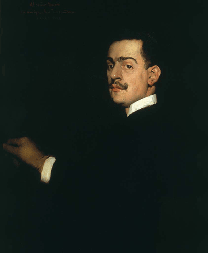
When Antonio died in 1917, Proust sent his brother Edouard a heartfelt condolence letter, longer than his usual missives, to express his sadness at losing a friend. By then, he was in financial troubles, and an acquaintance recommended he sell his extra furniture to Edouard, who ran an antiques gallery on Quai Voltaire. Proust rejected the suggestion, fearing that the antiquarian would misinterpret his intentions: 'The thought that [Edouard] could believe that I had this sale in mind when I wrote him the condolence letter, and that for this purpose I overstated my kindness, would be so disagreeable to me that I would prefer to make this transaction with another merchant.'
Though Antonio de La Gandara was born in Paris, many of his friends viewed him as a foreigner. Repeating the mistake – so common in the belle époque – of referring to Latin Americans as Spaniard by race, M. Antonio de La Gandara had made himself, in ten years, a considerable place in French art. He was not the only one to associate the painter with Spain. Before acquiring French citizenship in 1895, La Gandara had been required to exhibit in the Spanish section of the salons. Others got the nationality right but exaggerated his foreignness. Alphone Daudet once described him as 'having a Mexican waltz in his eyes' (des yeux de valse mexicaine), and Montesquiou penned the following portrait: 'Il y avait dans ce mexicain, de la grâce des premiers Aztèques, unie à la puissance latente du conquérant qu'il allait devenir. Cette dualité se résolvait en un mystère non dénué d'attrait, qui se compliquait de beaucoup d'autres.' (There was in this Mexican the grace of the first Aztecs, joined with the latent strength of the conquistador he would become. This duality resolved itself in a mystery, not devoid of charm, complicated by many others.) The count associates the painter with 'Les conquérants' and thus suggests a kinship between La Gandara and José-Maria de Heredia. It is striking that the count presents his friend as part Aztec, part conquistador – a description that anticipates Octavio Paz's theory of mestizaje and his vision of Mexicans as children of Spaniards and Indians.
La Gandara befriended Proust, painted Montesquiou and Yturri, knew Renaldo Hahn and his family, and crossed paths with Heredia at countless receptions and dinners. He was acquainted with many Latin Americans living in Paris and painted portraits of Chilean ambassador Alberto del Solar, Argentinean ambassador Enrique Larreta's wife, and Leonor Anchorena de Uriburi, a wealthy heiress from Buenos Aires. In 1885, La Gandara met Robert de Montesquiou, who had already commissioned portraits by Whistler, Blanche and Boldini. The narcissistic count became an important patron to La Gandara, commissioning at least four portraits of himself – an oil on ivory in 1885, a charcoal sketch in 1891, an undated pencil sketch, and an oil on canvas in 1892 – plus several more of Gabriel de Yturri, including an 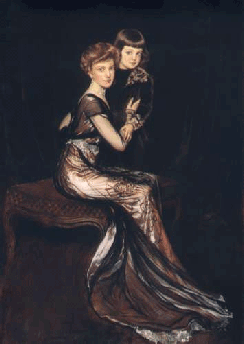 1886 oil on wood, now in the collections of the Musée d'Orsay in Paris, which the painter inscribed 'Al señor Yturri, su amigo Ant. De la Gandara'. Antonio was only a year older than Yturri, and the two [picture of AdeG's studio with the caption: 'La Gandara's painting studio. From left to right: Manuel de La Gandara, Gabriel de Yturri, Marie Zwanzi, unknown, the Villon brothers, model, Bon. Image courtesy Xavier Mathieu.'] bonded over their Latin American origins. Montesquiou credited Gabriel with launching the painter's career, and he regretted that La Gandara never completed his project of a more ambitious portrait of Gabriel. As he wrote in Le chancelier de fleurs: La réelle amitié qu'eut, pour lui [Yturri], Antonio de la Gandara, aurait dû avoir pour résultat un beau, un définitif portrait d'Yturri par cet artiste de mérite. J'ai le regret de devoir dire qu'il n'en est pas ainsi. Quand ce modèle rencontra ce peintre, ce dernier n'en était pas même à ses débuts dans la notoriété, que le premier favorisa de tout son pouvoir, qui était réel. Gandara fit alors quelques études peintes, pas très attachantes, de très jolis dessins à la mine de plomb, malheureusement emportés au pays, dont ils ne sont pas revenus. Plus tard, il y eut encore deux intéressants fusains; mais, je le répète, le grand, le beau, le vrai portrait qui était projeté, et sans doute allait s'accomplir, je le pleurerai toujours; et si mon compagnon revit dans ce Livre, l'avenir regrettera ce noble frontispice. (The true friendship Yturri had for Antonio de La Gandara should have resulted in a beautiful, definitive portrait of Yturri by this artist of merit. I am sorry to have to say that this is not the case. When the model met this painter, the latter had not even begun to enjoy notoriety, which the former supported with all his power, which was real. Gandara produced several not very attractive painted studies and some very pretty graphite drawings, unfortunately taken by him to the country, from where they never returned. Later, there were also two very interesting charcoals; but, I repeat, the great, the beautiful, the true portrait that was planned, and which doubtless was to be accomplished, I will regret it forever; and if my companion comes back to life in this book, the future will miss that noble frontispiece.)
1886 oil on wood, now in the collections of the Musée d'Orsay in Paris, which the painter inscribed 'Al señor Yturri, su amigo Ant. De la Gandara'. Antonio was only a year older than Yturri, and the two [picture of AdeG's studio with the caption: 'La Gandara's painting studio. From left to right: Manuel de La Gandara, Gabriel de Yturri, Marie Zwanzi, unknown, the Villon brothers, model, Bon. Image courtesy Xavier Mathieu.'] bonded over their Latin American origins. Montesquiou credited Gabriel with launching the painter's career, and he regretted that La Gandara never completed his project of a more ambitious portrait of Gabriel. As he wrote in Le chancelier de fleurs: La réelle amitié qu'eut, pour lui [Yturri], Antonio de la Gandara, aurait dû avoir pour résultat un beau, un définitif portrait d'Yturri par cet artiste de mérite. J'ai le regret de devoir dire qu'il n'en est pas ainsi. Quand ce modèle rencontra ce peintre, ce dernier n'en était pas même à ses débuts dans la notoriété, que le premier favorisa de tout son pouvoir, qui était réel. Gandara fit alors quelques études peintes, pas très attachantes, de très jolis dessins à la mine de plomb, malheureusement emportés au pays, dont ils ne sont pas revenus. Plus tard, il y eut encore deux intéressants fusains; mais, je le répète, le grand, le beau, le vrai portrait qui était projeté, et sans doute allait s'accomplir, je le pleurerai toujours; et si mon compagnon revit dans ce Livre, l'avenir regrettera ce noble frontispice. (The true friendship Yturri had for Antonio de La Gandara should have resulted in a beautiful, definitive portrait of Yturri by this artist of merit. I am sorry to have to say that this is not the case. When the model met this painter, the latter had not even begun to enjoy notoriety, which the former supported with all his power, which was real. Gandara produced several not very attractive painted studies and some very pretty graphite drawings, unfortunately taken by him to the country, from where they never returned. Later, there were also two very interesting charcoals; but, I repeat, the great, the beautiful, the true portrait that was planned, and which doubtless was to be accomplished, I will regret it forever; and if my companion comes back to life in this book, the future will miss that noble frontispiece.)
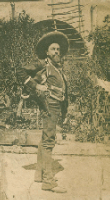 La Gandara traveled often, including several trips to the United States, but he never visited Mexico (unlike his brother Manuel, who made the journey in the last years of the century and had himself photographed in a charro outfit. In contrast to Heredia or Ramon Fernandez, he never achieved a following in Latin America, though his portraits of the belle époque would have been a great success in Porfirio Diaz's Mexico. Not even Alfonso Reyes, who was eternally on the look out for eccentric compatriots, encountered his work during his years at the Mexican embassy in Paris. Roberto Bolaño once wrote about 'Mexicans lost in Mexico'. La Gandara was a Mexican lost in Paris."
La Gandara traveled often, including several trips to the United States, but he never visited Mexico (unlike his brother Manuel, who made the journey in the last years of the century and had himself photographed in a charro outfit. In contrast to Heredia or Ramon Fernandez, he never achieved a following in Latin America, though his portraits of the belle époque would have been a great success in Porfirio Diaz's Mexico. Not even Alfonso Reyes, who was eternally on the look out for eccentric compatriots, encountered his work during his years at the Mexican embassy in Paris. Roberto Bolaño once wrote about 'Mexicans lost in Mexico'. La Gandara was a Mexican lost in Paris."
"(…) Paperolle number 3, “Proust’s Mexican Painter,” focuses on Antonio de La Gandara, a little-known society painter who was born in Paris to a Mexican father and an English mother. La Gandara knew Proust, and he painted portraits of several Latin Americans: Yturri, Hahn’s sister Maria, and the Chilean ambassador to France. Though La Gandara was born in Paris, he was considered an exotic foreigner; critics referred to him as a “Spaniard,” and Montesquiou once called him an “Aztec.” Like many of the characters in Proust’s novel, he was caught in the double bind of en être; he belonged … without ever fully belonging."